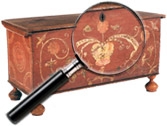Milton Clark Avery (American, 1885 to 1965)
Milton Avery was one of 20th century America’s foremost artists, known for his unique combination of color and abstraction, and his depiction of the natural world. Born in 1885 in Altmar, New York, Avery was interested in art from an early age. He studied art at the Connecticut League of Art Students in Hartford and the Art Society of Hartford, while working various factory jobs to support himself. He then moved to New York City, married Sally Michael, and began creating art full time. In New York he began exhibiting his work regularly and cultivating friendships with other artists, especially Mark Rothko, Adolph Gottlieb, and Marsden Hartley. Avery’s art, however, was individualistic; he rejected Rothko and Gottlieb’s manifesto on tragic and timeless subject matter, and the popular technique of complete abstraction.
Avery worked as an artist in the Easel Division of the WPA Federal Art Project while developing his signature style, a mixture of abstraction and figures with bold color choices. These works were usually painted from nature and his compositions were bold, geometric arrangements. He had his first major retrospective show at the Baltimore Museum of Art in 1952, and the Whitney Museum presented another retrospective in 1960. Avery’s work has had a profound impact on modern art in the late 20th century, and especially on color field painting.
Avery’s artistic style developed throughout his career, beginning with a combination of Impressionism with American regionalism and folk art. Later in his career, Avery focused on uniting color, form, and space. Avery’s grand late style paintings were larger in scale. In them he reduced forms to their essential characteristics, and used carefully balanced color.
Information courtesy of Skinner Inc., September 2007.
